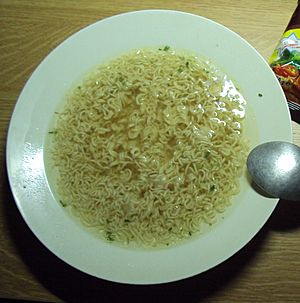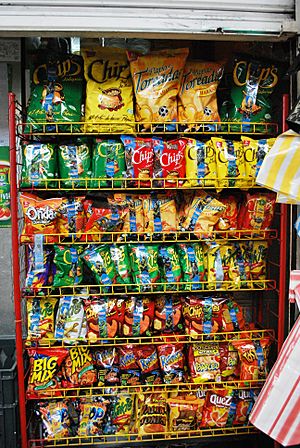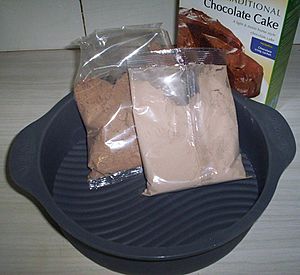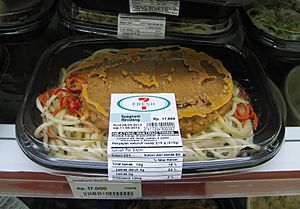Convenience food facts for kids


Convenience food is food that has been prepared to make it super easy to eat. It's often ready to go without much extra work. Think of it as food that saves you time and effort!
This kind of food is usually easy to carry, lasts a long time, or both. While restaurant meals are also easy, the term "convenience food" usually refers to things you buy at a store. Examples include ready-to-eat dry snacks, frozen foods like TV dinners, foods that can sit on a shelf for ages, and mixes like cake mix.
People have been selling bread, cheese, and salted food for thousands of years. But many modern convenience foods came about thanks to new food technology. Different countries have their own popular convenience foods. Some people worry about how healthy these foods are and how their packaging creates more trash. Many groups are working to make these foods healthier and help fight childhood obesity.
Contents
What is Convenience Food?
Convenience food is made to be easy to use. These products are often sold hot and ready to eat. They can also be shelf-stable (meaning they don't need to be refrigerated) or frozen. Frozen or refrigerated convenience foods usually need only a little preparation, like heating them up.
Both convenience foods and restaurant meals save you time. The main difference is that restaurant food is usually ready to eat right away. Convenience food often needs a small step, like heating. Both options usually cost more money than cooking a meal from scratch at home.
History of Easy Meals
People have always bought food from bakeries, creameries, and butcher shops to save time. Even the Aztecs in Central Mexico had convenience foods. They used dried, ground cornmeal called pinolli. Travelers just added water to it for a quick meal.
Canning and Freezing
Canned food was first made in the 1800s, mostly for soldiers. It became very popular during World War I. Making cans became much faster and cheaper after the 1850s. One person could make 15 times more cans each day with new machines.
One of the first big processed foods was meatpacking. After refrigerator cars were invented in 1878, meat could be processed far from where it was eaten. This meant fresh meat was available to more people.
World War II helped develop frozen foods. Many foods made for soldiers to last long and be easy to prepare later became popular for home use. After the war, food companies used their factories to make new frozen and canned foods. Some were very successful, like fish sticks and canned peaches. Others, like ham sticks or cheeseburgers-in-a-can, didn't do so well!
Modern Trends
By the 2010s, people in the United States started wanting more fresh, "natural", whole, and organic food. They were also more worried about their health. This made some big packaged food brands less popular. So, companies started making "healthier" versions of their foods or buying brands that already had a good reputation.
Different Kinds of Convenience Food
Convenience foods include many items you see every day. These can be candy, drinks like soft drinks and juices, fast food, nuts, fruits and vegetables (fresh or dried), processed meats and cheeses. Also, canned products like soups and pasta dishes are convenience foods. Other examples are frozen pizza, potato chips, pretzels, and cookies.
These foods often come in small, single-serving packages. This makes them easy to carry and eat on the go.
Why Some People Criticize Convenience Foods
Many people have concerns about these products:
- They are often made from ingredients that wouldn't be eaten raw.
- They can be high in fat and calories.
- They might not have many nutrients, even if they are fast to prepare. This is why some blame them for obesity.
- Their ingredients might come from genetically-modified organisms (GMOs).
- They almost always use preservatives to make them last longer.
Packaged Mixes
For thousands of years, mills have made flour for baking. More recently, flour has been sold with other ingredients already mixed in. These are called packaged mixes. They usually need some preparation and cooking, either in an oven or on a stove.
Packaged baking mixes often use special ingredients called leaveners. These help the food rise quickly and easily. This means you don't need to spend a lot of time or have special skills like you would for traditional yeast breads. These mixes make a type of quickbread.
Examples include cake mixes, macaroni and cheese, brownie mixes, and gravy mixes. Some packaged mixes can be high in saturated fat.
Convenience Foods Around the World
In Australia, people have been eating more convenience foods since 2007.
In Japan, onigiri (rice balls) are a very old and popular convenience food. They have been around for thousands of years. Other Japanese convenience foods include prepared tofu (bean curd), seafood packages, and instant ramen noodles.
Canned tuna packed in oil is a common convenience food in the Solomon Islands.
In Russia, frozen pelmeni are a popular type of meat dumpling. They have been around since at least the 1700s. Today, you can find industrially made and prepacked pelmeni in almost every supermarket freezer.
Selling Convenience Food
Sometimes, stores make more money selling convenience foods than they do selling the separate ingredients. This is one reason why you see so many of them!
In 1984, a survey in Great Britain found that over one-third of the money people spent on food was for convenience foods.
Worries About Health and the Environment
Many groups are concerned about the environment because of single-serving packaging. These packages often use a lot of plastics, which adds to solid waste in landfills.
Health organizations also worry about obesity and other health problems. This is because some convenience foods have a lot of fat, sugar, salt, food preservatives, and food additives.
In most developed countries, about 80% of the salt people eat comes from food prepared by companies. Only a small amount comes from natural salt or salt added while cooking. A single serving of many convenience foods can have a lot of the salt you need for a whole day. Food makers worry that if their products don't have enough salt, they won't taste as good and won't sell well.
Making Foods Healthier
To address concerns about convenience and restaurant foods, the United States started an initiative in 2010. First Lady Michelle Obama launched her Let's Move! campaign. Its goal was to make commercially produced food healthier and fight childhood obesity.
Mrs. Obama encouraged food companies to use less sugar and salt in their convenience foods. She preferred that companies make these changes themselves, rather than the government creating new laws. However, the Food and Drug Administration (FDA) did consider making these guidelines into laws. Other groups also looked into adding taxes on these products.
In response, in April 2010, sixteen food manufacturers agreed to lower salt levels in their products sold in the U.S. This program was similar to one in the United Kingdom. But some manufacturers resisted, saying that processed foods need high salt levels to taste good and hide bad flavors from processing. In May 2010, the group also decided to reduce the number of calories in foods. They planned to do this by offering lower-calorie foods, changing recipes, and making portion sizes smaller. They hoped to cut over 1.5 trillion calories by 2012.
Related pages
Images for kids
See also
 In Spanish: Plato preparado para niños
In Spanish: Plato preparado para niños





